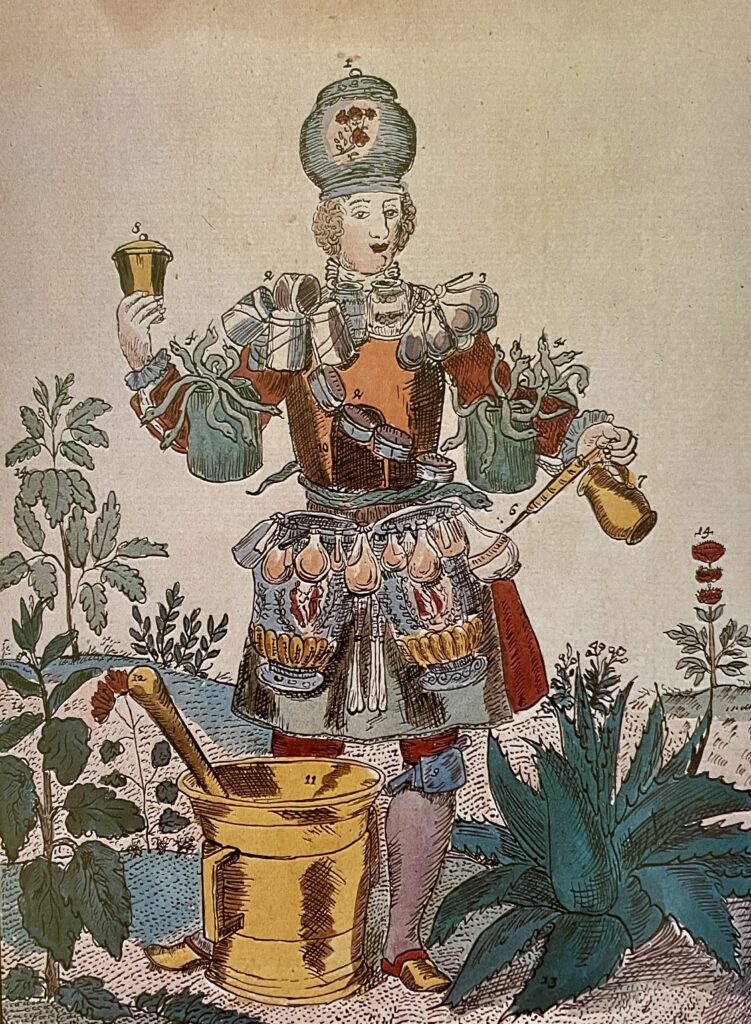Delicate herbs – lemon verbena, bayleaf, rosemary, lavender, lemon balm to name few – benefit from greenhouse cultivation, because they are either not cold hardy, or the open garden is shady, so the herbs don’t receive the minimum six hours of direct sunlight they require to do their best. Given a seat in a sunny south-facing window, and nighttime temperatures between 60°-55°F, you can keep a small harvest going over winter, or simply enjoy their scent and dream of soft, warm days in summer… or the Mediterranean, from where so many of our favorite herbs originate.

Or they might spin a tale of garden lore, and open your library shelves to the poetry of old herbals and such, handed down across centuries. One such poem is ‘Our Fathers of Old’, written in 1910 by Rudyard Kipling , who was inspired by Nicolas Culpeper’s Complete Herbal, in which Culpeper, an English physician and astrologer marries the benefits of various herbal plants with the planets as a guide to their beneficial use in treating diseases and disorders during the early 1600s. Here’s an excerpt to give you the flavor of Kipling’s poem and Culpeper’s practice:
Wonderful tales had our fathers of old —
Wonderful tales of the herbs and stars.
The Sun was lord of the Marigold
Basil and Rocket belonged to Mars.
Put us a sum in division it goes,
(Every plant had a star bespoke).
Who but Venus should govern the Rose?
Who but Jupiter own the Oak?
Simply and gravely the facts are told
In the wonderful books of our fathers of old.
Of course, the next stanza makes it clear the Kipling didn’t think much of Culpeper’s medical qualifications:
Wonderful little, when all is said,
Wonderful little our fathers knew.
Half their remedies cured you dead …
In Culpeper’s manual, under the heading ‘Tinctures’, is a recipe for Tinctura Fragoram, Tincture of Strawberries. Which at this time of year, with the strawberry harvest coming in from California, we might be tempted to make. Basically it involves steeping fresh strawberries in “spirits of wine” (vodka would work) over six days, straining and renewing with fresh berries each day, and then pouring the result into a clean bottle to be enjoyed at leisure. Culpeper dryly notes: “A fine thing for Gentlemen that have nothing else to do with their money, and it will have a lovely look to please their eyes.” There speaks confidence: You must admire Culpeper’s sarcasm since Gentlemen – and Women, who were included in that group – were his audience. (Update: A similar fine thing could be made with herbs and fruit — get your Bake-Off apron on and go wild.)

Three hundred years later, c. 1930, Mrs. C.F. Leyel in her book The Magic of Herbs, quoted Kipling and picking up on his contentious view of old-fashioned medicine, included a chapter titled ‘Quacks and Their Herbal Nostrums’, touching on the wilder shores of herbalism, like transmuting base metals to gold, and so forth. Such is the charm, not just of herbs and their history, but also antiquarian gardening books…talk about going down rabbit holes!
Herb-growing indoors is not complicated, but there are some special requirements: Pot up herb plants in early spring using roomy pots and a potting mix that is not too heavy on peat or other additive, since herbs like good drainage – you can add turkey grit to open up the compost, and I don’t bother putting shards over the drainage holes of the planting pots. Use deep pots for deeper-rooting shrubs; seed-sown annual herbs can be grown in windowboxes for easy harvesting and repeat sowing.
While a sunny, south aspect is best, indoor-grown herbs like a balanced climate that is somewhat humid, with good air circulation; if it’s dry and still, an occasional spritz with water helps, and use a fan to move the air around. Keep an eye out for pests…wooly aphids can be a nuisance. Since herbs are usually grown for eating, using a spray solution of two tablespoons of dishwashing liquid diluted in a gallon of water will help bugs; you may want to rinse the foliage off with clear water every so often to prevent soapy scum building up.
When all danger of frost is past, begin moving the pots outside, first to partial shade and then shift to their summer locations to gradually acclimate them to more sunlight. And on that note, I’ll toddle off into my sunny garden to rescue the container-growing herbs, including pineapple sage, lemon eucalyptus, the lemon verbena, basil, and rosemary that had been getting a breath of fresh air when the heavens opened, and the hail fell in sheets (for the fourth time in two weeks) and fairly shredded the plants.
I wonder if there’s some useful bit of herbal quackery to ward off hail? Let me know, okay?
©Ethne Clarke, 2023.
For the full version of Rudyard Kipling’s poem visit https://www.kiplingsociety.co.uk/poem/poems_fathersofold.htm


